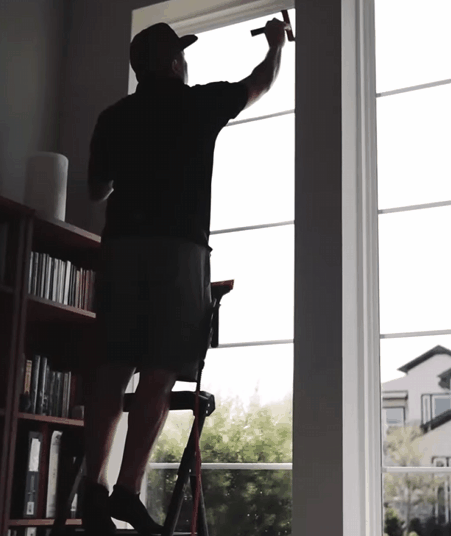Window tinting is an excellent way to enhance your home’s comfort, privacy, and energy efficiency, especially in a sun-drenched city like Houston, Texas. For homeowners looking to save on professional installation costs, DIY window tinting in Houston, Texas, offers an appealing alternative. However, while tackling a DIY project can be rewarding, it requires preparation, the right tools, and attention to detail.
In this guide, we’ll walk you through applying window tint film at home, discuss the benefits and challenges of DIY projects, and compare them to professional installations to help you make an informed decision.
Why Choose Window Tinting for Your Houston Home?
Houston’s climate is characterized by intense sunlight, high temperatures, and humidity. Window tinting addresses these challenges by:

- Reducing Heat: Specialized films like heat-reduction window films can block up to 70% of solar heat, keeping your home cooler and lowering energy bills.
- Providing Privacy: Tinted windows enhance privacy without sacrificing natural light.
- UV Protection: Window films block harmful UV rays, protecting your furniture, floors, and family.
- Enhancing Aesthetics: Tinted windows add a sleek and modern look to your home.
By improving indoor comfort and energy efficiency, residential window tinting in Houston is a practical and stylish investment for homeowners.
DIY Window Tinting vs. Professional Installation
Before diving into a DIY project, it’s important to weigh the pros and cons of doing it yourself versus hiring a professional.
Cost Comparison
DIY projects typically cost less upfront. A DIY window tint kit in Houston can range from $30 to $100, depending on the quality of the film and tools included. In contrast, professional installations may cost several hundred dollars, but they often include warranties and high-quality films like those offered by Commercial Film Specialists.
Skill Level and Results
Professional installers, such as Houston’s Best Residential Window Tinting Service, bring years of expertise and access to premium materials. DIY results can vary, with common issues like bubbles, peeling, or misaligned cuts.
Durability and Warranty
Professionally installed films often come with warranties covering defects and fading. DIY installations, however, rarely include such protections, putting the responsibility solely on the installer.
Time Investment
A professional team can complete a project in hours, while a DIY effort may take several days, especially if it’s your first attempt.


Let's Discuss Your Window Film Solution
At CFS we do things differently, we are masters of our craft. We take the extra steps necessary to make sure that each project is done the right way, from initial preparation to the final walk though. It matters not only in the end result but the longevity of the service. CFS founder Mike Norng, a nationally recognized PPF/Window tinting trainer, has taught installers all over the country how to install PPF and window tint with his advanced techniques.
Houston and surrounding area
Tools and Supplies You’ll Need for DIY Window Tinting
To successfully apply a window tint film at home, gather the following tools:
- Window Tint Film: Choose a film suitable for Houston’s climate, such as UV protection or heat-reduction films.
- Application Tools: A squeegee, utility knife, spray bottle, and lint-free cloth.
- Tinting Solution: A mixture of water and soap or a commercially available solution.
- Measuring Tools: A tape measure and cutting mat for precision.
Pro tip: Opt for high-quality materials, as cheap films may lack durability and scratch resistance. For supplies, look for window tinting supplies in Houston at local hardware stores or online.
Step-by-Step Guide to Applying Window Tint

Step 1: Clean the Windows
Use a lint-free cloth and cleaning solution to clean the surface thoroughly. Dust and grime can cause bubbles or prevent the film from adhering properly.
Step 2: Measure and Cut the Film
Measure your window and cut the film slightly larger than needed. This allows room for trimming once the film is applied.
Step 3: Prepare the Application Solution
Spray the window with the tinting solution, which acts as a lubricant for positioning the film.
Step 4: Apply the Tint
Peel off the film’s backing and carefully place it on the glass. Use a squeegee to smooth out any bubbles or wrinkles, working from the center outward.
Step 5: Trim Excess Film
Once the film is in place, trim the edges using a sharp utility knife for a clean finish.
Step 6: Allow Time to Cure
Depending on the climate, the adhesive may take a few days to a week to cure fully. Houston’s warm weather can speed up this process.
Common DIY Pitfalls and How to Avoid Them
Bubbles and Creases
Bubbles occur when dust or air gets trapped under the film. To avoid this, ensure the window is spotless and use a squeegee effectively during application.
Peeling Film
Peeling often results from poor adhesion. Selecting a high-quality film and following proper curing times can prevent this issue.
Not Adhering to Texas Window Tint Laws
Texas has specific regulations for window tinting, even for residential projects. For example, Texas window tint laws regulate Visible Light Transmission (VLT) percentages to ensure safety and compliance.
When to Consider Professional Installation
While DIY window tinting can be rewarding, some projects are better left to professionals.
- Large or Complex Windows: Unique shapes or oversized panes require precision and expertise.
- Premium Films: Advanced films, like security or decorative tints, may require specialized installation techniques.
Warranty Protection: Professionals, such as Commercial Film Specialists, offer warranties that provide peace of mind.
Conclusion
Window tinting offers numerous benefits for homeowners in Houston, from increased energy efficiency to enhanced privacy. While DIY window tinting is an option, it requires careful preparation, the right tools, and adherence to Texas regulations. For homeowners seeking guaranteed results and long-lasting performance, professional installation by experts like Commercial Film Specialists is a smart investment.
Frequently Asked Questions
Why is it important to follow Texas window tint laws?
Following tint laws ensures safety and compliance. Violating these regulations can result in penalties and affect your property’s resale value.
Can I achieve professional-quality results with DIY kits?
With the right tools and patience, you can achieve good results, but professional installations guarantee a flawless finish and added durability.
Why does Houston’s climate affect window tint performance?
High temperatures and humidity can impact the adhesive and curing process. Selecting climate-appropriate films ensures optimal performance.


